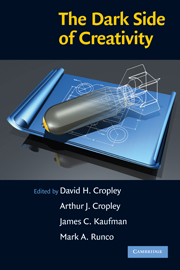Crossref Citations
This Book has been
cited by the following publications. This list is generated based on data provided by Crossref.
KAMPYLIS, PANAGIOTIS G.
and
VALTANEN, JURI
2010.
Redefining Creativity — Analyzing Definitions, Collocations, and Consequences.
The Journal of Creative Behavior,
Vol. 44,
Issue. 3,
p.
191.
Ekblom, Paul
2011.
Deconstructing CPTED… and Reconstructing it for Practice, Knowledge Management and Research.
European Journal on Criminal Policy and Research,
Vol. 17,
Issue. 1,
p.
7.
Cropley, Arthur
and
Cropley, David
2011.
Creativity and Lawbreaking.
Creativity Research Journal,
Vol. 23,
Issue. 4,
p.
313.
Meyer, Sunniva
and
Ekblom, Paul
2012.
Specifying the explosion-resistant railway carriage—a ‘bench’ test of the Security Function Framework.
Journal of Transportation Security,
Vol. 5,
Issue. 1,
p.
69.
Tan, Siu-Lan
Cohen, Annabel J.
Lipscomb, Scott D.
and
Kendall, Roger A.
2013.
The Psychology of Music in Multimedia.
p.
391.
Ambrose, Don
2013.
Socioeconomic Inequality and Giftedness: Suppression and Distortion of High Ability.
Roeper Review,
Vol. 35,
Issue. 2,
p.
81.
Gill, Paul
Horgan, John
Hunter, Samuel T.
and
D. Cushenbery, Lily
2013.
Malevolent Creativity in Terrorist Organizations.
The Journal of Creative Behavior,
Vol. 47,
Issue. 2,
p.
125.
Cropley, Arthur J.
2014.
Is There an ‘Arts Bias’ in theCreativity Research Journal? Comment on Glāveanu (2014).
Creativity Research Journal,
Vol. 26,
Issue. 3,
p.
368.
Webb, Angela Naomi
and
Rule, Audrey C.
2014.
Effects of Teacher Lesson Introduction on Second Graders’ Creativity in a Science/Literacy Integrated Unit on Health and Nutrition.
Early Childhood Education Journal,
Vol. 42,
Issue. 5,
p.
351.
Cropley, Arthur
2014.
The Ethics of Creativity.
p.
250.
Ambrose, Don
2014.
From the Editor’s Desk.
Roeper Review,
Vol. 36,
Issue. 3,
p.
137.
Lebuda, Izabela
2014.
Big C Research – The Big Challenge? Reflections from Research into Eminent Creativity in the Light of the Investment Theory of Creativity.
Creativity: Theories – Research – Applications,
Vol. 1,
Issue. 1,
p.
33.
Ekblom, Paul
2014.
Encyclopedia of Criminology and Criminal Justice.
p.
948.
Kőváry, Zoltán
Devecsery, Ágnes
Jakab, Krisztina
Pusztai, Barbara
Agócs, Laura
Kómár, Réka
and
Orosz, Gábor
2014.
Hungarian adaptation of Emotional Creativity Inventory (ECI).
Pszichológia,
Vol. 34,
Issue. 4,
p.
339.
Beghetto, Ronald A.
and
Kaufman, James C.
2014.
Classroom contexts for creativity.
High Ability Studies,
Vol. 25,
Issue. 1,
p.
53.
Sternberg, Robert J.
2014.
The Ethics of Creativity.
p.
62.
Cropley, David H.
2014.
The Ethics of Creativity.
p.
152.
Richards, Ruth
2014.
The Ethics of Creativity.
p.
119.
Ekblom, Paul
and
Pease, Ken
2014.
Encyclopedia of Criminology and Criminal Justice.
p.
2523.
Fink, Andreas
Weber, Bernhard
Koschutnig, Karl
Benedek, Mathias
Reishofer, Gernot
Ebner, Franz
Papousek, Ilona
and
Weiss, Elisabeth M.
2014.
Creativity and schizotypy from the neuroscience perspective.
Cognitive, Affective, & Behavioral Neuroscience,
Vol. 14,
Issue. 1,
p.
378.



